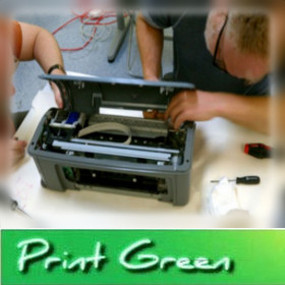
Photo Credit : Instructables BioPrinter
Bioprinting as an emerging technology, has gone through a lot of innovations and development that lead to its specific goal of achieving to develop new human tissues and organs. Through hard works and research done on bioprinters, full organs were produced and used by many which create a huge shift on their life.
If we will define it, Bioprinting or tissue engineering, is the process the produces organs via a printer that feeds biological materials. An inkjet printer is used as the machine, but instead of ink, cells are deposited on a surface layer by layer, thus an organ has been produced. 3D printer nowadays are being modified to produce the same output, however the success isn't that much.
Leaning to his own ingenuity, Patrik, one of the genius member of Instructables, modified an HP inkjet printer, and to his success he was able to transform that abandoned machine into a working DIY Bioprinter. For the complete information about Patrik's DIY Bioprinter, you may refer on the link here. Hacking an old inkjet printer isn't something new to hear, but the fact that it was transformed into a bioprinter is an amazing reason to give credits to this man.
Patrik and his team work with the inkjet printer by undressing it first, disassembling the components and covers, as well as reconstructing a new wire system for the paper handling mechanism. After checking if all the buttons are still working fine after all the alterations and modifications inside the printer, next thing they do is prepare the cartridges for a dissecting project. Since it's the printer uses inkjet technology, therefore the project requires inkjet cartridges, unless someone might take the challenge modifying a laser type printer, so there would be a bigger container such as a toner cartridge that can be filled with more biological materials. For printer users who practice green printing, consider opting for eco-friendly toner cartridges and ink cartridges for all your printing needs.
They open the cartridges that will be used and tried to fill it with biological materials. Making sure that even though they'll be using new cartridges, they make sure that it's been free from clog and residues, neither no holes, by rinsing each cartridges with distilled or deionized water. Then running a few test print to see if the cartridges and the printer synchronously work together.
With their first test print, the team printed arabinose over a half filter paper - placed on an agarose plate that lights up under UV light. To their success, they were able to print a BioCurious eyeball logo. Perhaps their project still needs some refining process to make it work as a fully functional BioPrinter.
If we will define it, Bioprinting or tissue engineering, is the process the produces organs via a printer that feeds biological materials. An inkjet printer is used as the machine, but instead of ink, cells are deposited on a surface layer by layer, thus an organ has been produced. 3D printer nowadays are being modified to produce the same output, however the success isn't that much.
Leaning to his own ingenuity, Patrik, one of the genius member of Instructables, modified an HP inkjet printer, and to his success he was able to transform that abandoned machine into a working DIY Bioprinter. For the complete information about Patrik's DIY Bioprinter, you may refer on the link here. Hacking an old inkjet printer isn't something new to hear, but the fact that it was transformed into a bioprinter is an amazing reason to give credits to this man.
Patrik and his team work with the inkjet printer by undressing it first, disassembling the components and covers, as well as reconstructing a new wire system for the paper handling mechanism. After checking if all the buttons are still working fine after all the alterations and modifications inside the printer, next thing they do is prepare the cartridges for a dissecting project. Since it's the printer uses inkjet technology, therefore the project requires inkjet cartridges, unless someone might take the challenge modifying a laser type printer, so there would be a bigger container such as a toner cartridge that can be filled with more biological materials. For printer users who practice green printing, consider opting for eco-friendly toner cartridges and ink cartridges for all your printing needs.
They open the cartridges that will be used and tried to fill it with biological materials. Making sure that even though they'll be using new cartridges, they make sure that it's been free from clog and residues, neither no holes, by rinsing each cartridges with distilled or deionized water. Then running a few test print to see if the cartridges and the printer synchronously work together.
With their first test print, the team printed arabinose over a half filter paper - placed on an agarose plate that lights up under UV light. To their success, they were able to print a BioCurious eyeball logo. Perhaps their project still needs some refining process to make it work as a fully functional BioPrinter.
 RSS Feed
RSS Feed